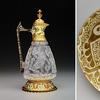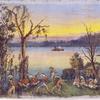MAJOR BORIS LURIE EXHIBITION AT THE DAVID DAVID GALLERY
- PHILADELPHIA, Pennsylvania
- /
- October 26, 2012
The Boris Lurie Art Foundation and David David Gallery are pleased to announce that a major exhibition of the work of Boris Lurie will take place at David David Gallery in Philadelphia, PA, from November 14 to December 12, 2012, with an opening reception on Wednesday, November 14, from 5pm to 8pm.
Born in Leningrad in 1924, Boris Lurie suffered the great upheavals of the Twentieth Century at first hand. His grandmother, mother, and sister were executed by the Nazis in the 1941 massacre at Rumbula, near Riga, and he and his father were interned at, and survived, a series of concentration camps, including Stutthof and Buchenwald. His coming of age in the depths of hell profoundly affected both his view of the world and the direction his art would take, and set him immediately apart from the artists among whom he found himself on his arrival in America after the war. As Sarah Schmerler remarked in her catalogue essay for Lurie’s 1998 gallery show, Bleed, 1969, “Most American artists of the Forties were fresh out of art school. Lurie was fresh out of Buchenwald.” There are deeply humane and inherently European aspects of his work, not to mention aggressively political dimensions, which rendered Lurie an alien presence in the New York art world of the forties through the seventies (and beyond). His animus against Abstract Expressionism, Neo-Dada, and Pop Art, with all of which movements aspects of his own work share certain visual and tactical qualities, is essentially a resistance against the widespread (and typically American) desire to leave the war behind and to forget its ravages in the midst of the wealth and optimism that victory and consequent economic ascendancy had engendered. Lurie was by no means stuck in the past, but having lived it, he refused to behave as if it had never happened, or that other horrors were not ever-present or constantly threatening. Lurie and his NO!art cohorts were among the precursors of the gradually expanding protest movement against the Vietnam War; they were among the first to thematize the threat of Nuclear Destruction in art; and they were certainly among the earliest Americans to decry the ascent of and the dehumanization caused by consumer culture, whose anti-human fallacies, like the Situationists in France, they exposed in their art. The great art critic Harold Rosenberg’s characterization of their work as “Pop, with venom added” doesn’t quite capture the depth or the seriousness of their mission.
NO!art began as a reaction against what it viewed as the debased avant-garde of Abstract Expressionism and its social and political dis-engagement, a resistance that would become all the more strident with the rise of Pop Art. How, it would ask, can art permit itself to be silently complicit with, or even indifferent to, the injustices and horrors being perpetrated around it, or, worse, to celebrate it’s own marginality and the pointlessness of resistance against the entrenched social, political, and commercial structures that dehumanize, oppress, and murder in the name of “freedom?” NO!art insisted that art address the real world, that it not surrender or sell its voice in the face of overwhelming force or irresistible blandishments. It called for an art dealing with difficult truths – imperialism, racism, sexism, consumerism, and nuclear proliferation – and leading to the fundamental, grass-roots social action that is their only possible remedy. Boris Lurie’s highly controversial work, sometimes combining imagery deriving from the Holocaust with samplings from popular culture, advertising, and girlie magazines, alienated critics and curators, and engendered misunderstandings about its intentions that still persist today. Although it energized and inspired many, including prominent artists and critics, and stirred the kind of controversy that is the life’s-blood of culture, it was ignored by the art establishment of its day.
But we are in the midst of a global re-assessment of the cultural life of the sixties and seventies, partly as a result of the widespread recognition that the goals of the social movements we associate with that period remain largely unrealized, and deep attention is beginning to be paid to the work of many genuinely progressive artists whose voices had been swept aside by the overwhelming public success of narrower and more superficial movements and the general perception that these were the relevant perspectives of their time. As the size and strength of the Occupy Movement has demonstrated, the humanistic ideals of the Anti-War Movement, the Civil Rights Movement, the Women’s Movement and, in fact, the Revolutionary Movements that resulted in the basic values to which much of the society to which they gave rise pays only lip-service, are far from dead. And they are very much alive in the art of Boris Lurie.
In the battle for the soul and humanity of art, Lurie was a hero of the resistance, the resistance against compromise, indifference, perversion, co-optation, and manipulation by the market. The great political artist Leon Golub is reported to have said, “Boris Lurie is the epitome of the engaged artist; he puts the rest of us to shame.”
In the years since his death in 2008, the Boris Lurie Art Foundation, established to support politically engaged art and to propagate the work of Boris Lurie, has mounted exhibitions of Lurie’s work at the Chelsea Art Museum in New York, at the Zverevsky Center for Contemporary Art in Moscow and at the Robert F. Kennedy Center for Justice and Human Rights at Le Murate in Piazza delle Murate, Florence, Italy.
David David Gallery
260 South 18th Street, Philadelphia, PA 19103
(215) 735-2922 -- f (215) 725-4244
Boris Lurie Art Foundation
50 Central Park West, New York, NY 10023
Contact:
Carl DavidDavid David Gallery
215-735-2922
info@daviddavidgallery.com
260 S. 18th Street
Philadelphia, Pennsylvania
info@daviddavidgallery.com
215-735-2922
http://www.daviddavidgallery.com
About David David Gallery
The David David Gallery, founded in 1910, is now in its 4th generation. Specializing in 17th-20th century American & European paintings, watercolors, drawings & sculptures, with a predominant focus on 19th/20th century works. Old Master to Modern Master, preeminent quality in conjunction with the pursuit of excellence is always the quest. Located just one half block south of Rittenhouse Square in Philadelphia, the gallery is open Monday through Friday 9:30-5:30 and Saturdays in season from 10-3. Your visit is welcome.

100x100_n.jpg)
100x100_c.jpg)













